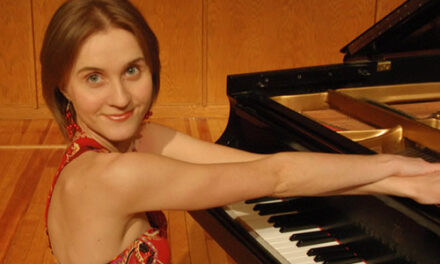The North Carolina School of the Arts (NCSA) is a unique state-supported arts institution that excels in exposing high school and college students to all aspects of professional artistic endeavors, although most of the time they learn their respective crafts in an isolated environment: dancers dance, musicians play concerts, and theater people emote within their own clique. In the 41-year history of the NCSA, there have only been a handful of productions where all departments of the school have come together. But nothing in the past has compared with their current production of West Side Story. They are in the midst of a ten-performance run at the Stevens Center in downtown Winston-Salem, and I urge you to get your tickets ASAP as empty seats for this monumental production are getting rarer by the minute.
There are several fortuitous events that have joined together to make this presentation of West Side Story even more special than it would normally have been. This is the 50th anniversary of the opening of this epochal American musical on Broadway, and John Mauceri, recently appointed Chancellor of NCSA, was an assistant to Leonard Bernstein and even helped edit the symphonic adaptation of the score. Several surviving members of the original Broadway cast were involved directly with preparations or simply made themselves available as resources for ideas and inspiration. The significance of this event is so far reaching that there was a symposium on May 4th featuring members of Bernstein’s family, and there will also be a special performance of this production at the Ravinia Festival in Chicago on June 8. I don’t mean to denigrate the dozens of other productions of this masterpiece that are almost always happening all over the world at any given time, but this one right in our own backyard is truly something special. To get an idea of the enormity of the preparations and other interesting background info click here for a special edition of the Kudzu Gazette — the student newspaper of the NCSA.
John Mauceri is not only the new Chancellor but also Musical Director; he conducted the NCSA orchestra in the very deep pit of the Stevens Center. He bounded out to the podium and the familiar strains of the Prologue and “The Jet Song.” It takes very little time to experience what was, at the time of its premiere, the revolutionary dancing, singing, acting and set design that all melded together in a way that changed the face of American musical theater. This opening ensemble piece set the stage for the excellence of all facets of this production. The weakest (as compared to the others) was the spoken dialogue. Several of the supporting characters had a somewhat wooden delivery, perhaps improving with confidence in subsequent shows. I had forgotten how small the Stevens Center stage is, so the dancing was even more spectacular when you consider the close quarters and real danger of falling into the pit.
Tony and Maria, the two leads of this Romeo & Juliet tale of young doomed lovers and familial/cultural feuds, were shared by two sets of actors. In this performance, Tony was played by Jordan Brown and Anna Wood was Maria. Jordan had the all-American looks and Broadway-style voice essential for this role. Wood sometimes faded in and out of her faux-Latino accent and for my taste had too much of a vibrato-laden operatic voice. They were especially wonderful together in the wedding scene where they profess their eternal love and sing “One Hand, One Heart.”
Jenna Fakhoury was spectacular as Anita, especially as a dancer. Her acting chops were also quite impressive during an attempted rape in the “Taunting Scene.” The two big dance numbers – “The Dance at the Gym” and the dream sequence — were complete shows all by themselves. Bravo to Susan McCullough, Dean, School of Dance, for this incredible choreography in a very limited space. There was so much excellence and professionalism throughout the show, but the set design and lighting was of such a high level that it’s doubtful that a show with a budget 1000 times this one could have duplicated it. From schoolyards and gyms to highway underpasses and candy stores, to bedrooms, and back again, this was a marvel that was the work of a huge group of carpenters and technicians.
Amid the hate and murders, probably the biggest crowd pleaser of the evening was the comic relief of “Officer Krupke.” Each of the Jets had a chance to describe their own particular “social disease” and the audience ate it up.
The orchestra played with great finesse and energy although they sometimes lacked the subtlety of jazz rhythms, especially during the famous “Cool” number.
You may never get a chance to experience West Side Story like this again. This is a story written and composed for all the characters to be teenagers. You will not likely find a more talented group of young artists than what the NCSA has given to us for this production. This run continues until May 13, 2007. Don’t delay — get your tickets right now!












